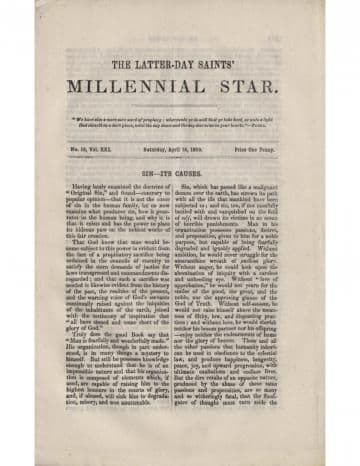Magazine
American Antiquities: Corroborative of the Book of Mormon (16 April 1859)

Title
American Antiquities: Corroborative of the Book of Mormon (16 April 1859)
Magazine
The Latter Day Saints' Millennial Star
Publication Type
Magazine Article
Year of Publication
1859
Editors
Calkin, Asa (Secondary)
Number of Pages
258
Date Published
16 April 1859
Volume
21
Issue Number
16
Abstract
This 47-part series provides evidence to confirm the authenticity of the Book of Mormon. It describes the contents of the Book of Mormon and archaeological findings and discoveries, such as ancient cities, temples, altars, tools, and wells. Each part contains several excerpts from other publications that support the Book of Mormon.
AMERICAN ANTIQUITIES,
CORROBORATIVE OF THE BOOK OF MORMON.
(Continued from page 242.)
(Extract from Captain Del Rio's Report of his Survey [in 1787] of the Antiquities of Yucatan and Chiapa, published in English in 1822.)
“From Palanque, the last town northward in the province of Ciudad Real de Chiapa, taking a south-westerly direction, and ascending a ridge of high land, that divides the kingdom of Guatemala from Yucatan, at the distance of six miles, is the little river Micol, whose waters flow in a westerly direction, and unite with the great river Tulijah, which bends its course towards the province of Tobasco. Having passed Micol, the ascent begins, and at half a league, or a mile-and-a-half, the traveller crosses a little stream called Otolum. From this point heaps of stone ruins are discovered, which render the roads very difficult for another half-league, when you gain the height whereon the stone houses are situated, being still 14 in number in one place, some more dilapidated than others, yet still having many of their apartments perfectly discernible. These stand on a rectangular area. 300 yards in breadth by 450 in length, which is a fraction over 56 rods wide, and 84 rods long, being in the whole circuit 280 rods, which is three-fourths of a mile and a trifle over. This area presents a plain at the base of the highest mountain forming the ridge. In the centre of this plain is situated the largest of the structures which have been as yet discovered among these ruins. It stands on a mound or pyramid 20 yards high, which is 60 feet, or nearly four rods in perpendicular altitude, which gives it a lofty and beautiful majesty, as if it were a temple suspended in the sky. This is surrounded by other edifices—namely, five to the northward, four to the southward, one to the south-west, and three to the eastward,—14 in all. In all directions the fragments of other fallen buildings are seen extending along the mountain that stretches east and west either way from these buildings, as if it were the great temple of worship, or their government-house, around which they built their city, and where dwelt their kings and officers of state. At this place was found a subterranean stone aqueduct, of great solidity and durability, which in its course passes beneath the largest building.”
(From the Christian Advocate and Journal.)
“On a mountain, called the Lookout Mountain, belonging to the vast Alleghany chain running between the Tennessee and Coos rivers, rising about 1,000 feet above the level of the surrounding valley,—the top of the mountain is mostly level, but presents to the eye an almost barren waste,—on this range, notwithstanding its height, a river has its source, and, after traversing it for about 70 miles, plunges over a precipice. The rock from which the water falls is circular and juts over considerably. Immediately below the full, on each side of the river, are bluffs, which rise about 200 feet. Around one of these bluffs the river makes a bend, which gives it the form of a peninsula. On the top of this are the remains of what are esteemed fortifications, which consist of a stone wall built on the very brow of this tremendous ledge. The whole length of the wall following the very course of the brink of this precipice is 37 rods and 8 feet, including about two acres of ground. The only descent from this place is between two rocks for about 30 feet, when a bench of the ledge presents itself from two to fire feet in width and 90 feet long. This bench is the only rod or path up from the water's edge to the summit. But just at the foot of the two rocks where they reach this path, and within 30 feet of the top of the rock, are five rooms, which have been formed by dint of labour. The entrance to these rooms is very small; but, when within, they are found to communicate with each other by doors or apertures.’
(To be continued.)
Subject Keywords
Bibliographic Citation
Terms of use
Items in the BMC Archive are made publicly available for non-commercial, private use. Inclusion within the BMC Archive does not imply endorsement. Items do not represent the official views of The Church of Jesus Christ of Latter-day Saints or of Book of Mormon Central.